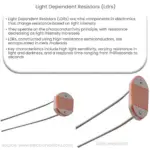A Light Dependent Resistor (LDR) is a resistor that changes its resistance with light intensity, commonly used in ambient light sensing and control.
Introduction to Light Dependent Resistors (LDR)
A Light Dependent Resistor (LDR), also known as a photoresistor, is a type of resistor whose resistance changes with the intensity of light it is exposed to. As the light level increases, the resistance of the LDR decreases, allowing more current to flow through it. This article will cover the basics of LDRs, their working principles, and common applications.
Composition and Working Principle
LDRs are made from semiconductor materials such as cadmium sulfide (CdS) or cadmium selenide (CdSe), which exhibit photoconductivity. When light photons strike the semiconductor material, they energize electrons, enabling them to move freely within the material. This increased electron mobility results in a decrease in the resistance of the LDR. The relationship between light intensity and resistance is nonlinear and can be characterized using a curve or an equation.
Types of LDRs
There are two main types of LDRs, based on their spectral response:
- Infrared-sensitive LDRs: These LDRs are sensitive to infrared light and are used in applications such as infrared remote controls and security systems.
- Visible light-sensitive LDRs: These LDRs are sensitive to visible light and are used in applications such as ambient light sensing and automatic lighting control.
Advantages and Limitations
LDRs have several advantages and limitations as light sensors:
- Advantages: LDRs are simple, low-cost, and easy to integrate into electronic circuits. They have a long life and are relatively immune to environmental factors such as temperature and humidity.
- Limitations: LDRs have a slow response time, making them unsuitable for high-speed applications. They also exhibit a nonlinear response and may require signal conditioning to provide accurate measurements.
Common Applications
LDRs are used in a variety of applications, including:
- Ambient light sensing: LDRs can be used to measure ambient light levels in devices such as smartphones, cameras, and display backlight control systems.
- Automatic lighting control: LDRs can be used in streetlights, garden lights, and indoor lighting systems to automatically switch lights on and off based on ambient light levels.
- Optocouplers and light barriers: LDRs can be used in conjunction with light-emitting diodes (LEDs) or other light sources to create optocouplers or light barriers for isolation and switching purposes.
Conclusion
Light Dependent Resistors are simple, low-cost light sensors that change their resistance based on the intensity of light. By understanding their working principles, advantages, limitations, and applications, you can effectively use LDRs in various light-sensing and control applications.
.png)



